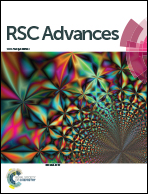Self-assembly formation of NiCo2O4 superstructures with porous architectures for electrochemical capacitors
Abstract
Nickel cobalt oxides (NiCo2O4) superstructures with microsized flowers (MF), nanoflowers (NF), nanoneedles (NN), and nanospheres (NS) have been prepared by a facile self-assembly formation and subsequent conversion process. The various morphologies of the nickel cobalt precursors (NCP) are tuned by using different salts, solvents, surfactants and reaction temperatures. The as-obtained NCP can be readily converted to NiCo2O4 through an annealing process with their structures well retained. The electrochemical properties of the as-derived NiCo2O4 are assessed as the active electrode materials. The results indicate that the NiCo2O4 has exhibited promising pseudo-capacitive properties with high capacitance and good cycling stability. The NF has delivered the highest specific capacitance of 636 F g−1 (at a rate of 1 mV s−1) among all the four samples, showing its potential application for next generation electrochemical capacitors.


 Please wait while we load your content...
Please wait while we load your content...